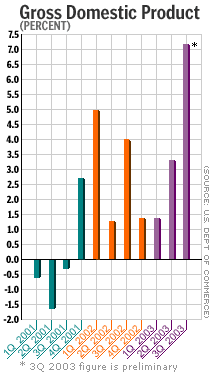NEW YORK (CNN/Money) -
After tirelessly carrying the U.S. economy in recent years, consumers are looking to pass the load to businesses, if only for a little while.
So far, businesses have been willing to do some spending of their own, especially in the third quarter, but whether robust spending continues -- and whether hiring picks up -- are far from a sure thing.
Business spending was through the roof in the third quarter, chugging along at the fastest pace since the good old days of the first quarter of 2000, back when some people could still say "Dow 30,000" with a straight face.

Business investment has, in fact, accelerated in three of the past four quarters, and spending on equipment and software has grown in five of the past six quarters.
Though consumer spending fuels more than two-thirds of the nation's economy, many analysts say continued business investment is needed to spur hiring and end the longest job-market slump since World War II.
"While consumer spending has been very strong, we are starting to see businesses spending now, and that is important to keeping the expansion going," said Paul Kasriel, senior economist at Northern Trust in Chicago. "Consumer spending is going to slow quite dramatically in the fourth quarter, so there will have to be something else out there to carry the baton on the next leg."
And there have been some hopeful signs lately that the recent pickup in business spending will continue. Profits and stock prices have risen and corporate bond markets have improved, making companies feel better and giving them more cash to invest in people and equipment.
Meanwhile, CEOs -- who for years were shell-shocked by the three-year bear market in stocks as well as corporate scandals -- are finally starting to sound less gloomy:
- A third-quarter survey by the Conference Board, a private research firm, found that 67 of 100 CEOs polled see business conditions improving
- An October survey by the National Association for Business Economics found 46 percent of 110 businesses expected to increase spending in the next year, compared with just 18 percent that plan to cut spending
- Robert Youngjohns, executive vice president of global sales for embattled business-computer maker Sun Microsystems (SUNW: Research, Estimates), told Reuters he saw a pickup in technology spending, echoing a report by private market research firm IDC that predicted tech and telecommunications spending recoveries next year
But Youngjohns wasn't completely ready to let the sun shine in, if you'll pardon the pun. Reuters reported that he said, "We would like to see six to 12 months of sustained improvement before we believe that the overall investment climate has improved -- there are too many false dawns in this business."
Mixed signals
And there are other signs that the future strength of business spending is not yet baked in the cake.
Earlier this month, the National Federation of Independent Business reported that just 26 percent of 555 small businesses surveyed plan to increase spending in the next three to six months, just barely above the record low of 25 percent hit in August 2002.
| Related stories
|

|
|
|
|
Small businesses are critical to the economy's health, employing at least half of all U.S. workers, according to some estimates.
And Goldman Sachs reported Friday that its industry analysts expect business spending to be flat in 2004, after falling an estimated 9 percent in 2003.
"The ... numbers feel surprisingly weak, compared with the recent [macroeconomic] news flow," Goldman Sachs economist Jan Hatzius wrote. "The survey makes us more comfortable with the view that capital spending growth over the next few quarters will remain relatively moderate by the standards of past recoveries."
Goldman Sachs expects business spending to rise at a 5 to 10 percent rate through the first half of 2004, a bit lower than the average pace after the 1991-92 recession, which was one of the slowest periods since World War II.
YOUR E-MAIL ALERTS
|
Follow the news that matters to you. Create your own alert to be notified on topics you're interested in.
Or, visit Popular Alerts for suggestions.
|
|
|
 |
Just as third-quarter consumer spending was driven by temporary factors such as cash from mortgage refinancing and child tax credit checks, business spending got a boost from depreciation allowances and pent-up demand from the spring, when businesses held their breath awaiting the outcome of the U.S.-led invasion of Iraq.
"Those factors caution against extrapolating the third-quarter surge," said UBS Warburg economist James O'Sullivan, who noted that factories, mines and utilities were only using about 75 percent of their production capacity, according to the latest Federal Reserve data.
O'Sullivan added, however, that capacity use nonetheless has been a pretty lousy indicator of future business spending. More telling, he and other economists say, could be September's 3.4 percent surge in new orders for non-defense capital goods excluding aircraft, a proxy for future business spending.
Still, much of that spending could be simply to replace worn-out equipment or to boost productivity to keep up with the competition -- none of which is particularly encouraging for future spending or job growth.
"Businesses are replacing computers, but they're not expanding -- they're improving what they already do," said Kevin Logan, chief economist at Dresdner, Kleinwort Wasserstein. "It may even let them get by with fewer workers."

|

